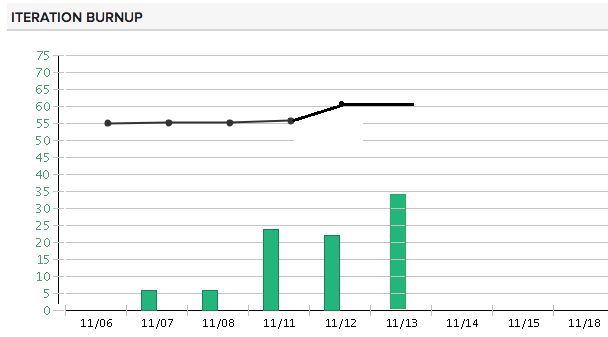If yo ur group likes to debate the information that displays the happenings of the dash, these pointers might assist. Team reflections on the previous Sprint get extra participating and inquisitive when the dialogue is backed up with group progress and supply developments.
Below is an inventory of few pointers that can be utilized to brainstorm their progress throughout the dash.
- The progress in direction of the dash aim,
- The impediments/dangers and the way did the group/administration huddle round these
- The group confidence vote on their dash forecast after the dash planning is finished on a scale of 1 to five utilizing the primary of 5 strategies. This is a superb enter for groups and managers to once more huddle round if the boldness is low on the dash commitments and what may be accomplished and the way can they self-organize to enhance confidence ranges. Was the dash execution in step with their confidence ranges
- Say-Do ratio (tales delivered versus tales deliberate)
- Spill Over (tales moved to the following dash)
- The story cycle time (time it takes for a narrative to maneuver from In-Progress to Done state)
- The Dev to QA handover timelines if any
Teams can use a number of the visible radiators listed beneath to seize the important thing knowledge developments for dialogue throughout retrospectives.
These are examples from Rally that is likely one of the agile lifecycle administration instruments for agile initiatives.
Sprint Burn down Chart- This chart shows work remaining and accomplished within the dash to proactively anticipate whether or not the dedicated work will likely be delivered by the dash finish date. It can also be helpful throughout dash retrospective conferences, to assist determine occasions throughout the dash or issues with estimation throughout planning.

- Remaining job hours are blue bars.
- Completed story factors are inexperienced bars.
- Ideal burn down fee is a black line, primarily based on the job estimate
Sprint Burn up Chart- Displays work delivered to this point within the dash to proactively anticipate whether or not the dash scope will likely be delivered.

- The vertical axis represents the accepted work in hours.
- The horizontal axis represents the dates.
- Completed story factors are inexperienced bars.
- Total scope of labor within the dash is a black line.
Cumulative Flow
The Cumulative Flow diagram shows the rolled-up states of all scheduled objects that will help you plan and monitor your sprints. This diagram shows all scheduled work objects for the dash in incremental collections of days because the horizontal axis. Each day shows the rolled-up states of all scheduled objects for the increment. The vertical axis of the chart references the whole plan estimates in your specified models.

Use this diagram to:
- Forecast and monitor progress: The states of the scheduled work objects point out the progress of your improvement because it strikes to completion. To decide if you’re on track to finish the work inside the scheduled dash, monitor the accepted state.
- Manage scope: As your scheduled work merchandise bars develop into degree, it’s straightforward to see when extra work is added to an dash. If the extent of the bars doesn’t stay uniform and as an alternative proceed to extend, that you must re-address the scope of your dash.
- Identify bottlenecks: Use the rolled-up states of your scheduled work objects to find out if there are developments that point out bottlenecks. For instance, a big part of scheduled objects in a accomplished state as in comparison with a small quantity of accepted might point out a testing roadblock.’
Sprint Defects by Priority- The Defects by Priority chart gives an at-a-glance view of all defects within the chosen dash, categorized by precedence and with any state worth aside from Closed. Use this chart that will help you shortly monitor and acknowledge the variety of defects of best significance, and to make sure defect decision is progressing in step with the dash time line. This chart is useful to confirm that an important defects are resolved first.

Velocity Chart
The Velocity chart shows all accepted plan estimate models for every of the final ten accomplished sprints. Use this chart to find out your dash velocity throughout initiatives inside scope within the present workspace.

Release Burn up Chart – A expend chart tracks how a lot work is finished. The burnup chart can present extra data than a burndown chart as a result of it additionally has a line exhibiting how a lot work is within the mission as entire (the scope as workload), and this will change. The burnup chart shows work delivered to this point within the launch to foretell whether or not the discharge date will likely be met.

Scope Change – This widget shows all work objects (person tales, defects, and defect
Suites) which have been added or faraway from dash, this provides a succinct view of whether or not scope is altering throughout the course of dash.

The Portfolio Item Timeline- This widget lets you visualize how portfolio objects are progressing over various time intervals. Portfolio managers, product managers, and different executives can use the app to shortly see if a portfolio merchandise is forward of schedule, in peril, or delayed in comparison with the deliberate begin and finish dates. Actual progress bars are coloured for fast reference to standing.

This knowledge pushed method is an instance of utilizing an inside-out approach-i.e. making a construction that can assist inculcate a tradition of collaboration and self-organization amongst groups together with the leaders by making utilizing very fundamental very important data seen and clear for inspecting and adapting the pattern.
Once the dialogue is finished utilizing a few of these visible radiators, groups may set goal targets like 5% improve in a selected space and provide you with an motion plan for getting there.
Reference- CA Rally Central Help
Source link

